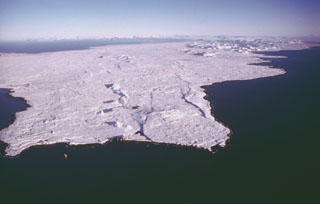Report on Reykjanes (Iceland) — 26 March-1 April 2025
Smithsonian Institution / US Geological Survey
Weekly Volcanic Activity Report, 26 March-1 April 2025
Managing Editor: Sally Sennert.
Please cite this report as:
Global Volcanism Program, 2025. Report on Reykjanes (Iceland) (Sennert, S, ed.). Weekly Volcanic Activity Report, 26 March-1 April 2025. Smithsonian Institution and US Geological Survey.
Reykjanes
Iceland
63.817°N, 22.717°W; summit elev. 140 m
All times are local (unless otherwise noted)
The Icelandic Meteorological Office (IMO) reported that an earthquake swarm at the Sundhnúkur crater row began at 0630 on 1 April, located between Stóra-Skógfell and Sýlingarfell within the Reykjanes volcanic system. Monitoring data showed related deformation, and pressure changes were detected in boreholes. IMO raised the Aviation Color Code to Orange (the second highest level on a four-color scale) at 0657 noting that magma was moving, and an eruption may begin within an hour or so. GPS signals indicated that magma was moving both NE and S towards Grindavík, and the intrusion was about 11 km long; emergency responders in Grindavík reported felt earthquakes and observed signs of deformation. According to a news report residents from about 40 occupied homes in Grindavík were evacuated; eight people decided to not evacuate. A M 4 earthquake was felt in Reykjavík.
A NE-SW-trending fissure opened at around 0945, just N of the protective barrier built around Grindavík, and by 1000 had grown to 500 m long. Lava fountains developed along the fissure and gas plumes rose about 2 km above the fissure. By 1024 the fissure had extended S and was erupting lava a few hundred meters inside the barrier, between the barrier and Grindavík; lava flowed slowly S. The Aviation Color Code was raised to Red at 1024 and then back to Orange at 1054; no ash was detected in the emissions. The fissure continued to extend S and by 1235 it was 1.2 km long and comprised of five segments. The nearest house was 500 m S. Seismicity continued to be detected along the length of the intrusion and was most intense at the N end, which extended more than 3 km beyond the extent of previous eruptive fissures. Lava traveled mainly NW at the N end of the fissure, mostly W and to a lesser extent to the E at the central portion of the fissure, and S from the S end of the fissure in the area between the barrier and the town. The Blue Lagoon spa area closed for the day according to a news report. Eruptive activity significantly decreased during 1340-1440, though seismicity was ongoing at both the N and S ends of the intrusion. Activity continued to decrease and by 1500 no activity was visible; drone and webcam recordings indicated only minor activity. Seismicity at the S end of the intrusion, near Grindavík, had decreased. Seismicity at the N end continued at a similar intensity and shifted even further N; earthquakes were located almost 9 km more N than the northernmost eruption fissure during the August 2024 eruption. The largest earthquakes was around a M 3 and was felt in Vogar, 7 km NW of the activity.
Geological Summary. The Reykjanes volcanic system at the SW tip of the Reykjanes Peninsula, where the Mid-Atlantic Ridge rises above sea level, comprises a broad area of postglacial basaltic crater rows and small shield volcanoes. The submarine Reykjaneshryggur volcanic system is contiguous with and is considered part of the Reykjanes volcanic system, which is the westernmost of a series of four closely-spaced en-echelon fissure systems that extend diagonally across the Reykjanes Peninsula. Most of the subaerial part of the system (also known as the Reykjanes/Svartsengi volcanic system) is covered by Holocene lavas. Subaerial eruptions have occurred in historical time during the 13th century at several locations on the NE-SW-trending fissure system, and numerous submarine eruptions dating back to the 12th century have been observed during historical time, some of which have formed ephemeral islands. Basaltic rocks of probable Holocene age have been recovered during dredging operations, and tephra deposits from earlier Holocene eruptions are preserved on the nearby Reykjanes Peninsula.
Sources: Icelandic Meteorological Office (IMO), Icelandic National Broadcasting Service (RUV)

